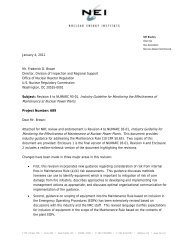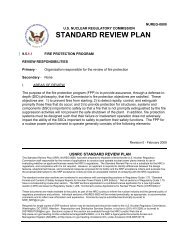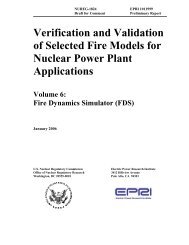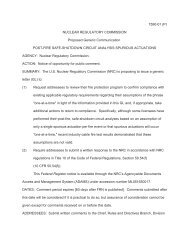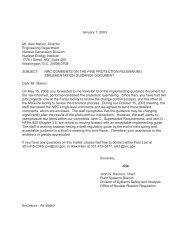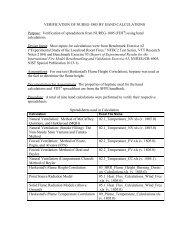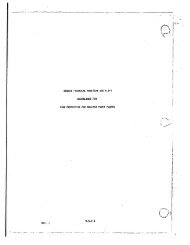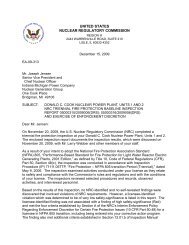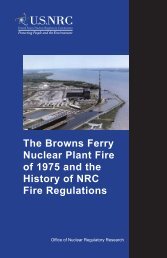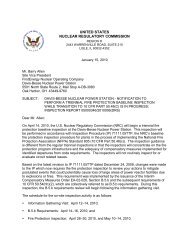NUREG/CR-6850, Volume 1 - NRC
NUREG/CR-6850, Volume 1 - NRC
NUREG/CR-6850, Volume 1 - NRC
You also want an ePaper? Increase the reach of your titles
YUMPU automatically turns print PDFs into web optimized ePapers that Google loves.
Conclusions and Closing RemarksThe second step in the fire severity assessment deals more directly with fire severity as aphysical property of a fire. Fire intensity (e.g., fire heat release rate (HRR)) is a critical factor inthe fire modeling input assumptions. Under the recommended approach, a fire intensitydistribution is assigned to each fire ignition source. The assigned intensity profile directlyincorporates the severity/likelihood concept.These two steps are integral and highly dependent on each other. That is, given the initialscreening conducted in the analysis of fire event data, the retained fire events represent a rangeof fire intensities. Many fires will ultimately reach only a modest intensity even if left uncheckedby fire suppression efforts. Other fires involving the same fire ignition source might grow to highintensity. This reflects the random behavior of fires.The fire intensity profile is intended to represent the potential fire behavior of a given fireignition source should the fire be allowed to grow unchecked. Under this approach, a net fireseverity factor can be estimated on a scenario-specific basis. The severity factor represents thefraction of the fire intensity distribution that lies above the minimum fire intensity leading to firespread and damage. The severity factor is calculated for each unique fire scenario based on thespecific conditions relevant to that scenario (e.g., proximity of secondary combustibles,proximity of damage targets, damage target failure criteria, compartment conditions, etc.).3.2.5 Detection and Suppression AnalysisThe analysis of detection and suppression in past Fire PRAs has typically involved one of twoapproaches; namely, use of historical evidence regarding fire duration gleaned from the fireevents, or use of fire brigade response times as demonstrated by unannounced fire drills. Theanalysis method documented here combines aspects of both approaches.The overall fire detection/suppression process is captured in an event tree. Quantificationinvolves two factors; namely, the split fractions associated with each event in the event tree,and the event transition times.One specific aspect of the fire suppression analysis is the manual fire brigade. In therecommended approach, the fire brigade response is assessed based on the scenario-specificbrigade response time and historical evidence regarding fire suppression times for similar fires.Fire suppression time curves are derived for various groupings of specific fire ignition sources,fire locations, and fire types based on analysis of the fire event database (FEDB).3.2.6 Circuit AnalysisThe issue of circuit analysis, including the spurious operation of components and systems,continues to be an area of significant technical challenge. The approaches recommended hereprovide a structured framework for the incorporation of fire-unique cable failure modes andeffects in the Fire PRA. The circuit analysis issue impacts Fire PRA methods and practicebroadly. Circuit analysis impacts the following steps:• Identification of Fire PRA components and cables,• Mapping of Fire PRA components and cables to fire analysis compartments,3-5





